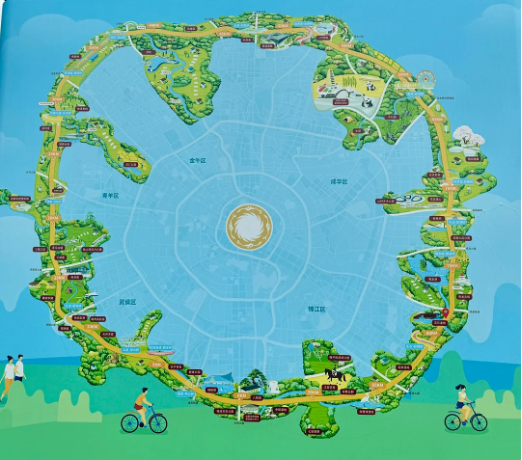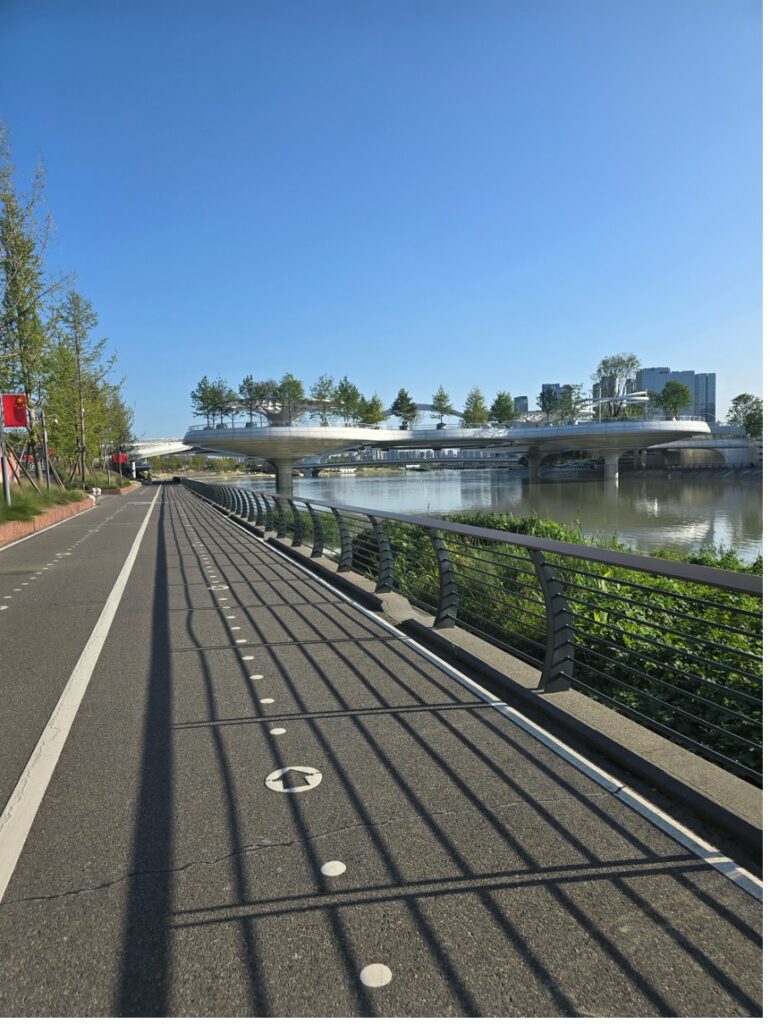China's New Cycling Infrastructure: A Ride Through Chengdu’s 100 km Greenway
Our mobility consultant Moniek Jansen recently traveled across Asia and Oceania, exploring cycling infrastructure in different cities. In this blog series, she shares her experiences and insights from the road. First stop: Chengdu, China!
Chengdu, the capital of Sichuan province in China, is famous for its pandas, spicy hotpot, and laid-back lifestyle. But beyond the food and wildlife, the city is rapidly becoming a model for urban planning, thanks to the ambitious Tianfu Greenway project. At the heart of this plan is a 100 km-long cycling loop (the Green Belt) that winds through the city’s parks, rivers, and cultural landmarks. But how well does this new cycling infrastructure actually work? And what can other cities learn from this massive project? Let’s take a closer look.
A Cycling Route that Connects the City
The Tianfu Greenway is part of a much larger vision 20,000 km of interconnected green trails designed to transform Chengdu into a ‘Park City’. The first phase was completed in 2020, and by 2025, an additional 1,920 km will be added. Eventually, by 2040, the entire city will be connected through an extensive web of green corridors, linking parks, cultural landmarks, and even schools
As cycling tourist, the 100 km cycling loop was the real highlight for me. Unlike many Chinese cities where bike infrastructure feels like an afterthought (or even non-existent), this route is designed to flow naturally, avoiding abrupt stops and confusing intersections. It offers an uninterrupted ride through some of Chengdu’s most scenic spots, making cycling an enjoyable experience.

A Perfect Blend of Scenic and Practical Cycling Infrastructure
In many cities, cycle highways are built for speed and efficiency, focusing on direct routes for commuters. Chengdu’s greenway takes a different approach, emphasizing leisure and connectivity. The route meanders through lush parks, quiet riversides, and cultural sites like Qingyang Palace, Kuanzhai Alley, and Du Fu Thatched Cottage. This makes it ideal for a relaxed ride, but it still serves a practical function by avoiding congested roads. Instead of weaving through heavy traffic, cyclists can glide through peaceful green spaces, enjoying a stress-free journey. Okay, the distance is longer, but cyclists are much faster, safer and more comfortable than passing right through the city.
That being said, for those who need to get somewhere quickly, some sections may feel a bit too indirect. Integrating more direct links between the greenway and key urban hubs could make it even more useful for everyday commuting.
A Comfortable and Safe Ride
For many people, one of the biggest barriers to urban cycling is safety. Chengdu’s greenway addresses this by completely separating the greenway from motor traffic, creating a low-stress, family-friendly environment. The paths are well-lit, well-paved, and regularly maintained. There are also plenty of rest areas, clean public toilets, water stations, and even bike repair points along the way, making long-distance rides more convenient.
However, one area for improvement is the transition between the greenway and city streets. Because you need somehow to cycle from and towards the greenway from the inner city. More clear connections to main roads and public transport hubs could make it easier for cyclists to hop on and off the route without confusion. Another point of improvement is shade. The greenway has lots of shade from the trees, but once you enter an open area of a few kilometers, it is crazily hot.


How does it compare to other cycling networks, for example in the Netherlands?
Chengdu’s greenway shares some similarities with the Dutch approach to cycling infrastructure:
- Well-connected: Like Dutch cycle highways, it provides a continuous route, making long rides easy and enjoyable.
- Beautiful surroundings: The scenic nature of the route makes cycling a pleasure, rather than just a way to get from A to B.
- Safe and accessible: The separation from motor vehicles ensures a stress-free ride for cyclists of all ages.
But there are also some challenges:
- More recreational than commuter-focused: While Dutch cycle highways prioritize efficiency, Chengdu’s greenway leans towards leisure. Commuters might find some sections a bit too winding.
- Fewer direct links to public transport: In the Netherlands, cycle highways often connect seamlessly with train stations and transit hubs. Chengdu could benefit from a similar approach to improve multi-modal travel.
Takeaways for Cycling Tourism and City Planning
The Chengdu Greenway is an impressive example of how cycling can be integrated into a city’s long-term vision. It highlights the potential of urban cycling beyond daily commutes – creating spaces that promote leisure, health, and tourism. However, for it to be a true daily commute and alternative for car travel, better connections to key city areas and transport networks are needed.
Chengdu’s greenway showcases the potential of cycling as an experience—something many big and heated cities could benefit from. Especially since you can find touristic/leisure attractions along the cycleway, together with clean public toilets, restaurants, parks, etc.
At Mobycon, we specialize in designing tailor-made cycling solutions that fit each city’s unique needs. Whether it’s developing cycling tourism, optimizing commuter routes, or creating green recreational spaces, we help cities build cycling infrastructure that is safe, attractive, and accessible. Want to explore how your city can become more cycling-friendly? Let’s talk!

